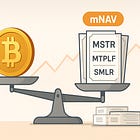🏃♂️💨 The Stacking Sprint
FIRE BTC #38 - Four years to financial freedom
I used to think of pursuing FIRE as an all-or-nothing endeavor. Like a switch that’s either on or off. You’re either financially free or you’re not.
But now that I’ve crossed that threshold, and it doesn’t really matter for me anymore, I’ve realized there might be a better way to think about it.
At some point in your FIRE journey, the momentum of your savings starts doing the heavy lifting. Adding more doesn’t move the needle as much. It’s hard to say exactly when that shift happens, but I want to offer a rule of thumb that captures the idea. One that gives you permission to start living like you’re free, even before you technically are.
I call this the Stacking Sprint—a focused period of extreme saving and stacking to build your base.
For most people, four years is the sweet spot. It lines up with bitcoin’s halving cycle, is long enough to change your life, and short enough to stay motivated.
⚡ The Stacking Sprint
Pursuing FIRE is often framed as more of a marathon, and that’s the mindset I adopted through most of my journey. Sure, I was trying to save as much as possible, as fast as possible, but in hindsight, the “marathon” framing was limiting.
It’s a vague, open-ended approach that can wear on you over time. And I believe it unnecessarily delays the point when you can loosen up and actually enjoy your wealth.
But what if you could front-load the effort? What if you went all-in for a focused stretch of ruthless stacking, then shifted into a more relaxed, coasting mode?
The Stacking Sprint is about finding that balance. Build a strong enough foundation early, and you can pull forward the point where your savings rate drops and your lifestyle spending increases without jeopardizing your long-term goal or even meaningfully delaying it.
It all hinges on understanding that compounding creates an inflection point where, after a certain threshold, each additional sat has a smaller impact on your path to financial freedom. In other words, there’s a point of diminishing returns.
If you haven’t read my writing on the power of compounding, check it out below.
📉 Diminishing returns on additional saving
In the early days of building your stack, every bit of effort moves the needle. You’re starting from basically zero, so a 10% increase might mean going from 0.1 BTC to 0.11 BTC. That’s something you can realistically achieve just by staying disciplined with your savings. At today’s prices (~$120k/BTC), that’s $1,200—doable in days, weeks, or months at most.
But fast forward a few years. Once you’ve built a solid base, that same 10% gets exponentially harder. Going from 1 BTC to 1.1 BTC means saving $12,000. From 5 BTC to 5.5 BTC? That’s $60,000. And growing from 10 to 11 BTC means stacking another $120,000.
And that’s if bitcoin’s price stays flat. If the price doubles or triples while you’re trying to add more, achieving that growth trajectory only gets harder. I don’t know if you’ve noticed, but bitcoin has a habit of doing just that in very short periods of time.
It’s the same pattern we see with Bitcoin Treasury Companies. Early on, they can grow their BTC per share quickly by stacking aggressively on a small baseline. But as their BTC NAV grows, their BTC yield drops, and it gets harder to justify the stock trading at a premium.
If you want a deeper dive on this dynamic, check out my recent FIRE BTC issue on mNAV here:
This is just the math catching up. The bigger your stack, the harder it is to grow it further through brute-force saving. You’re battling both bitcoin’s asymmetric upside and the law of diminishing returns.
The good news is: you don’t have to.
At a certain point, stacking more becomes marginal. Over time, each additional sat may yield similar dollar gains, but those gains barely move the needle relative to what you’ve already built.
That’s why the Stacking Sprint works. It takes advantage of the phase when your effort is most efficient—before compounding takes over and stacking becomes increasingly expensive.
🛣 From sprinting to coasting
The Stacking Sprint isn’t meant to last forever, which is why I call it a “sprint”.
After a few focused years of intentional saving, aggressive stacking, and delayed gratification, the game starts to change. Your foundation is built, and compounding is working in your favor. Bitcoin is doing the heavy lifting.
This is when you can strategically enter the coasting phase.
The Stacking Sprint sets you up for a more relaxed phase where you’re no longer scrutinizing every expense or delaying gratification until you hit your FIRE number. You can let off the gas, spend more freely, and start saying yes to the things you postponed during the sprint: more travel, more hobbies, more time with friends, a bit more comfort and ease.
You’re still on track, because your stack is growing in the background. You’ve front-loaded the hard work and can now start enjoying life a little more freely—earlier than you otherwise would if you waited until your FIRE number is hit.
Perhaps that means exploring work outside of your job.
The Stacking Sprint isn’t about permanent sacrifice—it’s about creating the conditions for sustainable freedom early. It puts you in a position to start living better before you retire, knowing you’re not trading your future for short-term comfort like a lot of people do.
🧠 Reframing your FIRE approach
One of the most common challenges people face after reaching financial independence is learning how to actually enjoy it.
They’ve spent years grinding, optimizing, and delaying gratification. Those habits are hard to shake. Even when they’re objectively well off, they struggle to loosen up. They keep running the old playbook, even though they’ve already won the game. I have struggled with this personally.
FIRE teaches you how to save, but not how to spend.
The Stacking Sprint helps reframe that. It gives you a mental container for the hard part. You front-load the discipline, then intentionally shift into a new phase that allows you to improve your lifestyle without putting your future financial freedom at risk.
Sprint when it counts the most. Then coast your way to FIRE, and let bitcoin do the heavy lifting.
That’s it for this week — thanks for reading!
Until next time,
Trey ✌️




Thanks for the insight. I call it an excitingly scary journey.
Let Bitcoin do the heavy lifting 💪🏾